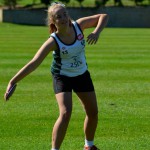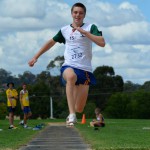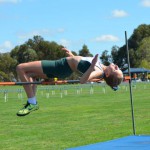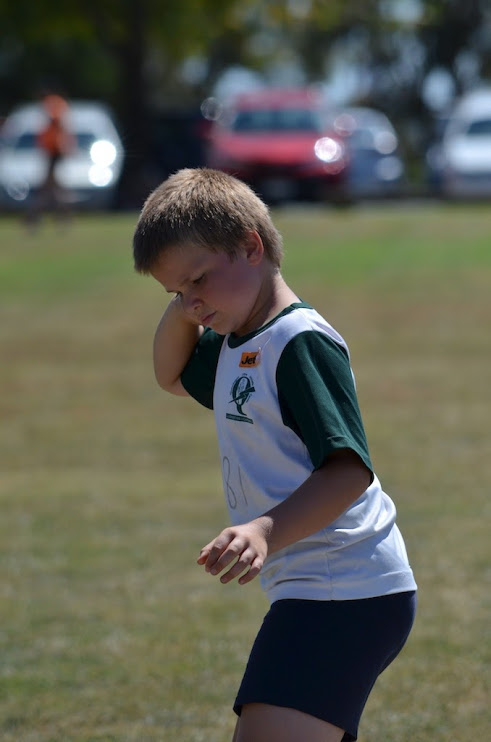Page Contents
Field Events
The LAACT has a series of fact sheets for events that provide specific information for each event type, summarised here for field events.
Event Layout at Wright Park
Field Events include:
Shot Put
What you need to know about shot put.
| Age Group | Weight | Colour |
| U6 & U7 | 1 kg | (Blue) |
| U8 | 1.5kg | (Yellow) |
| U9–U11, U12G | 2kg | (Orange) |
| U12-U14B, U13–U15G | 3kg | (White) |
| U15-16B, U16 & U17G | 4kg | (Red) |
| U17B | 5kg | (Green) |
 Shoes must be worn. Each competitor can have up to three attempts. A competitor must commence the shot put from a stationary position inside the circle, e.g. any glide across the circle must commence with the athlete in a stationary position inside the circle. The shot must be put from the shoulder with one hand only. The shot must be held touching the neck or the chin and the hand shall not be dropped below this position during the put.
Shoes must be worn. Each competitor can have up to three attempts. A competitor must commence the shot put from a stationary position inside the circle, e.g. any glide across the circle must commence with the athlete in a stationary position inside the circle. The shot must be put from the shoulder with one hand only. The shot must be held touching the neck or the chin and the hand shall not be dropped below this position during the put.
The shot must land in the sector. On the line is out. If the shot lands in the sector and then skids outside the sector it is a legal attempt.
The competitor must not leave the circle until the shot has landed. The competitor must not touch the top of the stop board, or circle, or ground beyond the circle. The competitor must leave from the rear half of the circle.
The throw is measured from the nearest mark made by the shot to the inside of the circumference of the circle, along a line from the landing point to the centre of the circle.
All measurements are made to the nearest centimetre below the measured distance e.g. both 4.351m and 4.358m are rounded down to 4.35m.
Discus
What you need to know about discus
| Age Group | Weight |
| U6 & U7 | 350g |
| U8 – U10 | 500g |
| U11 & U12, U13G | 750g |
| U13 – U16B, U14 – U17G | 1kg |
| U17B | 1.5kg |
 Shoes must be worn. Flat soled shoes are best for this event. Each competitor can have up to three attempts. A competitor must commence the discus throw from a stationary position inside the circle. Where an athlete uses a glide technique, the glide across the circle must commence with the athlete in a stationary position inside the circle.
Shoes must be worn. Flat soled shoes are best for this event. Each competitor can have up to three attempts. A competitor must commence the discus throw from a stationary position inside the circle. Where an athlete uses a glide technique, the glide across the circle must commence with the athlete in a stationary position inside the circle.
The discus must land in the sector. On the line is out. If the discus lands in the sector and then skids outside the sector it is a legal throw.
The competitor must not leave the circle until the discus has landed. The competitor must not touch the top of the stop board, or circle, or ground beyond the circle. The competitor must leave from the rear half of the circle.
The throw is measured from the nearest mark made by the discus to the inside of the circumference of the circle, along a line from the landing point to the centre of the circle.
All measurements are made to the nearest centimetre below the measured distance e.g. both 8.351m and 8.358m are rounded down to 8.35m.
Javelin
What you need to know about javelin
| Age Group | Weight |
| U11 & U12, U13G | 400g |
| U14-U17G | 500g |
| U13 – U14B | 600g |
| U15 – 17B | 700g |
 Shoes or spikes must be worn. Each competitor can have up to three attempts. The javelin must be held at the grip. The javelin is thrown over the shoulder or upper part of the throwing arm and must not be slung or hurled. In the course of their attempt, a competitor must not touch the lines which make up the boundary of the throwing area or the ground outside.
Shoes or spikes must be worn. Each competitor can have up to three attempts. The javelin must be held at the grip. The javelin is thrown over the shoulder or upper part of the throwing arm and must not be slung or hurled. In the course of their attempt, a competitor must not touch the lines which make up the boundary of the throwing area or the ground outside.
The javelin must land within the sector. On the line is out. A fair throw is made when the judge considers that the tip of the javelin lands first. If the javelin lands in the sector and then skids out, it is a fair throw, and is measured from the point of first contact. The competitor must not leave the runway until the javelin has landed.
When a competitor leaves the runway first contact with the parallel lines or the ground outside must be completely behind the arc at the top of the throwing area. Spikes can be worn for this event, but care must be taken to be safe.
A throw is measured from the nearest mark made by the javelin to the inside edge of the arc, along a line from the landing point to the centre of the circle of the arc.
All measurements are made to the nearest centimetre below the measured distance e.g. both 12.351m and 12.358m are rounded down to 12.35m.
Turbo javelin and long tom javelin
Turbo Jav is designed as a step toward the introduction of standard javelin in Under 11s. Under 10s use a Long Tom Javelin to better prepare for the Javelin in U11s. As part of this process, the event will be run with normal javelin rules, but with the lighter and safer Turbo Jav.
 Shoes must be worn. Spikes are NOT to be worn for this event. Each competitor can have up to three attempts. The turbo jav must be held at the grip. The turbo jav is thrown over the shoulder or upper part of the throwing arm and must not be slung or hurled. In the course of their attempt, a competitor must not touch the lines which make up the boundary of the throwing area or the ground outside.
Shoes must be worn. Spikes are NOT to be worn for this event. Each competitor can have up to three attempts. The turbo jav must be held at the grip. The turbo jav is thrown over the shoulder or upper part of the throwing arm and must not be slung or hurled. In the course of their attempt, a competitor must not touch the lines which make up the boundary of the throwing area or the ground outside.
The turbo jav must land within the sector. On the line is out. A fair throw is made when the judge considers that the tip of the turbo jav lands first. If the turbo jav lands in the sector and then skids out, it is a fair throw, and is measured from the point of first contact.
The competitor must not leave the runway until the turbo jav has landed. When a competitor leaves the runway first contact with the parallel lines or the ground outside must be completely behind the arc at the top of the throwing area.
All measurements are made to the nearest centimetre below the measured distance e.g. both 9.351m and 9.358m are rounded down to 9.35m.
Long Jump
What you need to know about long jump
 In long jump, athletes run up a track and jump into a sandpit with measurements taken from the front of the foot landing in the take-off area to the back of the foot in the pit. Shoes must be worn, spikes can be worn from U9. Each athlete has up to 3 attempts. A technique fact sheet is here.
In long jump, athletes run up a track and jump into a sandpit with measurements taken from the front of the foot landing in the take-off area to the back of the foot in the pit. Shoes must be worn, spikes can be worn from U9. Each athlete has up to 3 attempts. A technique fact sheet is here.
Take-off Point
For U6 and U7 the take-off area starts 50cm from the edge of the pit. A ‘mat’ of sand measuring 1m x 1m is created for the athletes to use as a guide for where to take off.
For U8 and U9 the ‘mat’ of sand remains at 1m x 1m but it is set up 1m back from the edge of the pit. For U10 to U12 the ‘mat’ of sand measures 1m x 0.5m. This ‘mat’ is to be 1m from the front edge of the mat to the start of the pit. This is the ‘take-off area’.
For U13 to U17, the mat of sand is replaced by a 20cm wide white line 1m back from the edge of the pit.
Failures
A jump is a failure if:
- Any part of the foot goes over the front edge of the take-off point, whether running up without jumping or in the act of jumping.
- The competitor touches the ground between the take-off area and the pit.
- After completing a jump the competitor walks back through the pit.
For U13 to U17, measurements are taken from the front of the take-off line to the break in the sand in the pit that is nearest to the take-off mat. This break in the sand can be made by any part of the body e.g. if the competitor falls at the end of the jump, this could be the elbow or hand rather than the foot.
If the competitor takes off from behind the take-off area, the jump is measured from the back edge of the take-off area. All measurements are made to the nearest centimetre below the measured distance e.g. both 2.351m and 2.358m are rounded down to 2.35m.
Triple Jump
What you need to know about triple jump
 Athletes U11 and up compete in triple jump. Shoes or spikes must be worn. Each competitor can have up to 3 attempts. The triple jump consists of a hop, followed by a step (both of which land on the runway) and is completed by a jump that lands in the pit.
Athletes U11 and up compete in triple jump. Shoes or spikes must be worn. Each competitor can have up to 3 attempts. The triple jump consists of a hop, followed by a step (both of which land on the runway) and is completed by a jump that lands in the pit.
A number of take-off lines are painted on the triple jump runway (at 3m, 5m, 7m and 9m from the pit). Competitors choose one of these lines as their take off point.
For U11 and U12 age group the mat will be a 0.5m x 1m mat. In selecting the appropriate take- off line, the athlete needs to ensure that they land both the hop and step on the runway but complete the jump into the pit. As a guide, competitors should be consistently jumping 3m into the pit from their current take-off line before moving back to a new take-off line. From the new line they should be then jumping about 1m into the pit and should not risk landing on the runway or edge of the pit. e.g. if a competitor is jumping from the 5m line, they should be consistently jumping 8m before they attempt to use the 7m take off line.
Failures
A jump is a failure if:
- Any part of the foot goes over the leading edge of the nominated take-off line, whether running up without jumping or in the act of jumping.
- The competitor touches the ground between the take-off area and the pit other than in the normal hop and step phases, e.g. landing the jump on the runway is a failure.
- The competitor does not complete the hop, step and jump in that order.
- After completing a jump the competitor walks back through the pit.
- It is NOT a failure if a competitor touches the ground with the ‘sleeping’ foot, e.g. it is not a failure if the athlete takes off for the hop on their right foot, but the left foot brushes the runway before they land the hop.
If the competitor takes off from behind the take-off line, the jump is measured from the front edge of the take-off line.
High Jump
What you need to know about high jump
| Age Group | Starting Height |
| U9 | 75cm |
| U10 | 85cm |
| U11 | 95cm |
| U12 | 100cm |
| U13 | 105cm |
| U14 | 110cm |
| U15 | 115cm |
| U16 & U17 | 120cm |
 Shoes or spikes must be worn. Each competitor attempts to jump the bar in turn. Once an athlete clears a height they wait until the bar goes up to the next height while the remaining athletes have another attempt. If an athlete has three consecutive misses they are eliminated from the competition.
Shoes or spikes must be worn. Each competitor attempts to jump the bar in turn. Once an athlete clears a height they wait until the bar goes up to the next height while the remaining athletes have another attempt. If an athlete has three consecutive misses they are eliminated from the competition.
A flexi-bar may be used for the first week of competition in the under 9 and under 10 age groups for the starting height only. A scissors jump is the preferred jump for U9-U10. A fact sheet on scissors technique is here.
Competitors have up to one minute from the time their name is called to complete their attempt. Usually the full time isn’t required. However, it does allow competitors to have two (or possibly three) false starts. This won’t be a failure provided they complete their attempt in the allocated time and as long as they don’t touch the ground or mats beyond the uprights without first clearing the bar.
When all competitors have completed their attempts at a height (either cleared or eliminated) the bar is raised by 5cm. When there are 6 or less competitors left in the event, the bar is raised by a minimum of 2cm.
Competitors may pass at any height or forego an attempt and come back into the competition at a higher height. However should an athlete have three (3) consecutive misses, regardless of height, they are eliminated from the competition.
Failures
A jump is a failure if:
- After their jump attempt the bar does not remain on the supports because of the action of the competitor while jumping.
- The competitor touches the ground or the landing area beyond the uprights without first clearing the bar.
- The competitor takes off from two feet.
- When it is clear that the bar has been displaced by a force not associated with a competitor, e.g. a gust of wind, a new attempt will be awarded.


